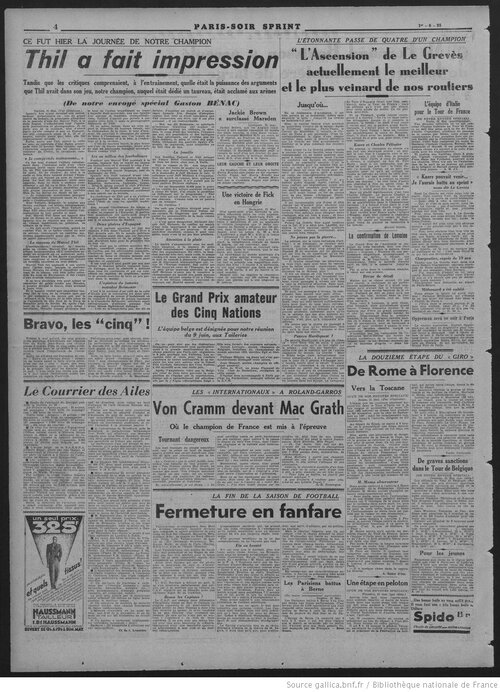From TU 137 & 170,
Mr. Beau gliders.
It might be better to assign these glider designs to GRAL (
Groupe rouennais d'aviation légère or Rouen light aviation group). Ferdinand Beau may have been an instrumental in the design of some of these gliders but not all. Established designer Robert Landes is mentioned in the text and club member Jean David also assisted M. Beau with design and construction. Some designs - like the GRAL 7 - seem to have been overall club efforts.
All of the GRAL gliders were one-offs and mostly short-lived. BTW, the name
Bamboula is a play on
bambou (bamboo being the GRAL-1's major construction material). The
bamboula is an African drum (and its associated dance). Fabric-covered wood (or bamboo) dominated GRAL designs but fuselages (or pods) were plywood or veneer-covered.
Some bio ... As noted in your TU clipping, Ferdinand Beau and his wife were deported to Birkenau. Beau was a member of the Resistance active in the
Ligne Comète which aided downed Allied airmen. Beau died in Auschwitz on 15 May 1944, aged 49.
Also mentioned was GRAL co-founder/President, Marc Hauchermaille. A
Sergent chef instructor at Le Mans in June 1940, he fled to Britain to join the FAFL.
Sous-Lieutenant Hauchermaille was 35 when killed in action in his No.340 (Free French) Squadron
Spitfire Vb (BL786) after tangling with Fw 190s off Ostend.
----------------
GRAL - Groupe rouennais d'aviation légère Glider Designations
GRAL 1 -
Bamboula 1931 single-seat '
ultra-léger' glider, x 1
- GRAL 1: Single-bay biplane, open-frame tail supports, span 6.00 m
-- Roll controllers* later mounted on wing struts, Robert Landes design
-- Orig. no ailerons, the '
commandes de roulis' added later
GRAL 2 - 1931 single-seat parasol monoplane, ply-covered fuselage*, x 1
- GRAL 2: Primarily fabric-covered bamboo & plywood construction
-- Test flown by Hauchemaille, abandoned as too heavy & unwieldy
GRAL 3 - 1931 single-seat parasol monoplane, veneer-covered fuselage, x 1
- GRAL 3: High-aspect ration wing, GRAL 16% profile, span 12.86 m
- GRAL 3: Design F. Beau with Jean David;* wrecked by Beau 05 Apr 1931
-- David also oversaw GRAL-3 component constr. by two local firms*
-- * Duvert et Cie (wood work) & Ateliers Savary (metal components)
GRAL 4 - 1931
La Limande single-seat shoulder-winged glider, x 1
- GRAL 4: Intended as tesbed for GRAL wing designs, span (??) m
- GRAL 4: Design F. Beau, named for flat* fabric-covered fuselage
-- *
Limande from the Common Dab (a North Sea flatfish)
- GRAL 4: Flew 10 Feb 1931,
La Limande wrecked March 1931
GRAL 5 - 1932* prone-pilot light/elementary training glider, x 1
- GRAL 5: Open-frame fuselage, fabric-covered wood, span 10.00 m
- GRAL 5: Lightweight glider inspired by slightly heavier Avia 11-A
-- Constr. actually compl. 24 May 1932, damaged (w/o?) 28 May 1933
GRAL 6 - 1932 pod-and-boom development* of GRAL 5 light glider, x 1
- GRAL 6: Fabric-covered fuselage pod, longer wings, span 13.00 m
-- * Financed by future GRAL
président, M. Maurice Collet
GRAL 7 -
Lévitan* 1932 single-seat training glider, x 1
- GRAL 7: Open-framed glider inspired by Avia 10-A, span 12.00 m
-- *
Lévitan after funder, funiture-maker Meubles Lévitan
GRAL-8 - 1932 improvement upon GRAL 7 design, podded fuselage, x 1
- GRAL 8: GRAL 7 w/ GRAL 6-style pod, span 14.00 m (w/ rounded tips)


![Les_Ailes___journal_hebdomadaire_[...]_bpt6k65552142_12.jpeg](/data/attachments/170/170468-8a415e26927251942a2f86c8cc538ce9.jpg)



















![Toute_l'aviation_Ouvrage_honoré_de_[...]Blanc_Edmond_bpt6k9807582h_273.jpeg](/data/attachments/182/182552-d7109e48949aa40d89aa074b3edf769c.jpg)

![Toute_l'aviation_Ouvrage_honoré_de_[...]Blanc_Edmond_bpt6k9807582h_297.jpeg](/data/attachments/182/182609-de379154ae228121586a3559e82ac563.jpg)




![L'Auto-vélo___automobilisme_cyclisme_athlétisme_[...]_bpt6k4629446z_2.jpeg](/data/attachments/183/183436-3f787922baa9cf6c3db05db4978393fe.jpg)
![Le_Petit_Parisien___journal_[...]_bpt6k607016r_1.jpeg](/data/attachments/183/183437-e97946ed3b4ad93563bca3fb6cd8ba06.jpg)



![Revue_aéronautique_de_France___[...]Ligue_aéronautique_bpt6k6139672m_12.jpeg](/data/attachments/183/183460-8d5933855de49e5df3f7dbd3fc056e8a.jpg)
